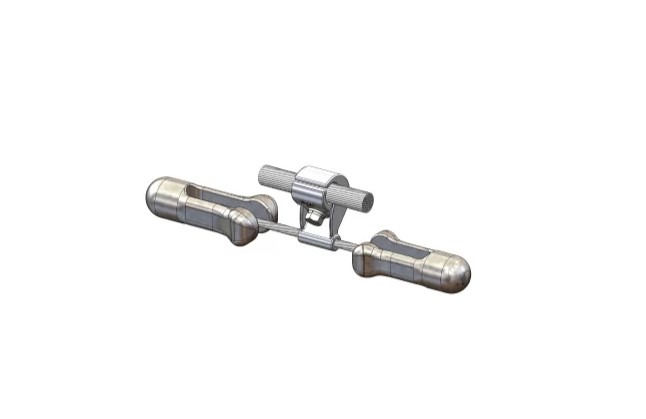The efficient and reliable delivery of electricity across vast distances is paramount in power transmission. High-voltage transmission lines, which carry electrical energy from power plants to substations and then to consumers, are subjected to a range of environmental and mechanical stresses. Among these stresses, vibration, and oscillation are significant concerns that can compromise the integrity and performance of the transmission lines.
To mitigate these issues, spacer dampers and vibration dampers are employed. These components are crucial for maintaining power transmission lines’ stability, efficiency, and longevity.
In this blog, IAC Electricals, an electrical hardware fittings and accessories manufacturer in India explores what spacer dampers and vibration dampers are, their applications, and their importance in the power transmission industry.
Spacer Dampers: What Are They?
Spacer dampers are devices used primarily in bundle conductor transmission lines. Bundle conductors consist of two or more conductors per phase, spaced apart and connected in parallel to carry the electrical load. Spacer dampers serve two main functions: they maintain the physical spacing between the conductors and dampen the vibrations caused by wind and other environmental factors.
Applications of Spacer Dampers:
Maintaining Conductor Spacing:
The primary function of spacer dampers is to maintain the uniform spacing between bundle conductors. This spacing is crucial to prevent electrical arcing and to ensure efficient power transmission. By keeping the conductors evenly spaced, spacer dampers reduce the risk of electrical faults and improve the overall reliability of the transmission line.
Damping Aeolian Vibrations:
Aeolian vibrations are low-amplitude, high-frequency oscillations caused by wind passing over the conductors. These vibrations can lead to conductor fatigue, causing wear and tear over time. Spacer dampers help dampen these vibrations, reducing the mechanical stress on the conductors and extending their lifespan.
Mitigating Subspan Oscillations:
Subspan oscillations occur when the conductors between spacers oscillate in a manner similar to skipping rope. These oscillations can cause severe damage to the conductors and fittings. Spacer dampers effectively mitigate these oscillations, ensuring the structural integrity of the transmission line.
Reducing Galloping:
Galloping is a low-frequency, high-amplitude oscillation caused by wind-induced aerodynamic forces. It can lead to severe conductor damage and even lead to phase-to-phase faults. Spacer dampers help reduce the amplitude of galloping, minimizing the risk of damage and outages.
Vibration Dampers: What Are They?
Vibration dampers are devices designed to dissipate the energy of mechanical vibrations in transmission lines. These dampers are particularly effective against wind-induced vibrations and can be installed on both single and bundle conductors. The most common types of vibration dampers are Stockbridge dampers, which consist of two masses connected by a flexible cable.
Applications of Vibration Dampers:
Damping Aeolian Vibrations:
Similar to spacer dampers, vibration dampers are primarily used to counteract aeolian vibrations. By dissipating the energy of these vibrations, vibration dampers reduce the risk of conductor fatigue and extend the service life of the transmission lines.
Preventing Conductor Damage:
Continuous exposure to vibrations can cause micro-cracks and wear on conductors, eventually leading to failure. Vibration dampers prevent this by minimizing the amplitude and frequency of the vibrations, thus protecting the conductors from long-term damage.
Enhancing System Reliability:
By reducing the mechanical stresses on conductors and fittings, vibration dampers enhance the overall reliability of the power transmission system. This results in fewer maintenance requirements, reduced downtime, and lower operational costs.
Improving Safety:
Vibration dampers play a critical role in improving the safety of power transmission lines. By preventing conductor fatigue and potential failures, they help avoid dangerous situations such as conductor snapping and falling, which can pose significant risks to personnel and infrastructure.
Importance of Spacer Dampers and Vibration Dampers:
Here are the top 5 importance of Space Dampers and Vibration Dampers. Let’s check them out to understand more about Space dampers and vibration Dampers.
Extending Lifespan of Transmission Lines:
The use of spacer dampers and vibration dampers significantly extends the lifespan of transmission lines. By reducing mechanical stresses and preventing fatigue, these devices ensure that the conductors and fittings remain in good condition for longer periods, thus minimizing the need for frequent replacements.
Enhancing Transmission Efficiency:
Maintaining proper conductor spacing and reducing vibrations enhance the efficiency of power transmission. This results in lower electrical losses and improved performance of the transmission system.
Reducing Maintenance Costs:
By mitigating vibrations and oscillations, spacer dampers and vibration dampers reduce the wear and tear on transmission lines. This leads to lower maintenance costs, as the need for repairs and replacements is minimized.
Ensuring System Reliability:
The reliability of power transmission systems is crucial for ensuring a consistent and uninterrupted supply of electricity. Spacer dampers and vibration dampers play a vital role in maintaining this reliability by preventing mechanical failures and enhancing the overall stability of the transmission lines.
Supporting Grid Stability:
Stable and reliable transmission lines are essential for maintaining grid stability. By mitigating the effects of wind-induced vibrations and other environmental factors, spacer dampers and vibration dampers help ensure that the power grid remains stable and capable of meeting the demands of consumers.
Final Words
Spacer dampers and vibration dampers are indispensable components in the power transmission industry. Their ability to maintain conductor spacing, dampen vibrations, and prevent mechanical failures is critical for the efficient and reliable operation of transmission lines.
By extending the lifespan of conductors, reducing maintenance costs, and enhancing system reliability, these devices play a crucial role in ensuring a stable and uninterrupted supply of electricity. As the electricity demand continues to grow, the importance of spacer dampers and vibration dampers in maintaining the integrity of power transmission infrastructure cannot be overstated. If you have any queries, you can contact IAC Electricals, your one-stop company for substation hardware fittings.






